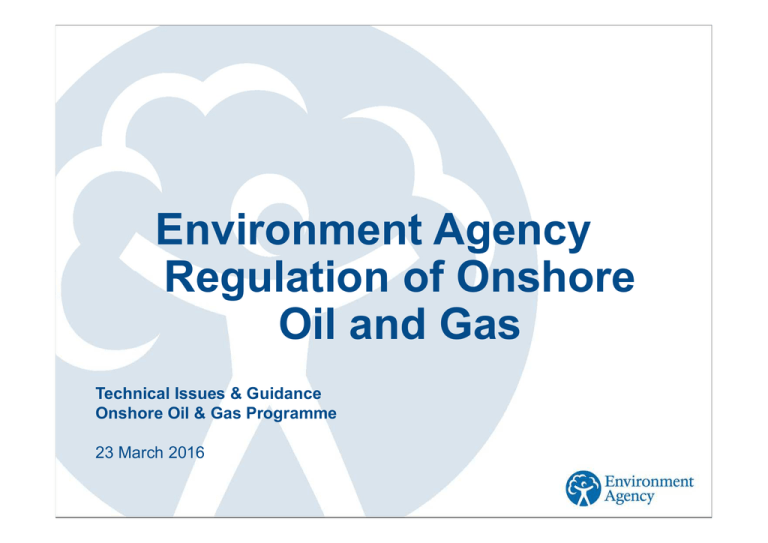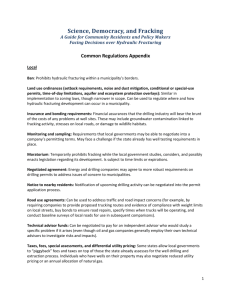EA PAS March 2016 General - pdf [Read
advertisement

Environment Agency Regulation of Onshore Oil and Gas Technical Issues & Guidance Onshore Oil & Gas Programme 23 March 2016 Overview of the presentation Onshore oil and gas potential in South East How our regulations apply to the onshore oil and gas industry Our permitting process Our approach to regulation How we interact with the other regulators Questions 3 4 5 What we regulate How we regulate onshore oil and gas Environmental Permits Mining Waste Directive Groundwater discharge Surface water discharge Industrial Emissions Directive Radioactive Substances Regulations Other Consents Water Resources Act Flood risk consent 7 How do we define fracking? Infrastructure Act 2015 hydraulic fracturing of shale or strata encased in shale which is — carried out to search or bore for or get petroleum, and involves, or is expected to involve, the injection of more than 1,000m³ of fluid at each stage or more than 10,000m³ in total. 8 The permitting process (site of high public interest) Application ‘duly made’ Public consultation (20 working days) Technical assessment of application Determination and draft decision consultation (20 working days) Consider final representations Announce final decision 9 Permitting Considerations 1 Permit for all extractive wastes, including Drill cuttings, spent drilling fluids, returning fracturing fluids, waste gases and any stimulation fluids left behind. Require a Waste Management Plan that: Characterise wastes, and describe risks Set out mitigations, in line with waste hierarchy Discloses chemical additives Sets out monitoring and closure plans 10 Permitting Considerations 2 Availability and protection of groundwater Environmental Permit for a Groundwater Activity No drilling in SPZ1 or where activity would have an unacceptable effect on groundwater Detailed evaluation of risks to groundwater and mitigation measures Assessment of chemical additives to be used S199 Notice of Intention to Drill This will detail: how the well will be drilled and cased, storage of substances including fuel and chemicals, proposed drilling fluid management plan 11 Permitting Considerations 3 Flaring of waste gas during exploration >10 tonnes/day = Industrial Emissions Directive <10tonnes/day = Mining waste Directive Flaring converts methane to CO₂ Radioactive Substances Regulations Naturally Occurring Radioactive Material – NORM Surrender of permits once all regulated activities have ceased 12 Our approach to regulation All our regulatory activities are risk based Inspection – examining the activities or infrastructure at a permitted site Auditing – detailed review of specific elements including checking of records & procedures Monitoring – checking information provided Advice and Guidance Enforcement Health & Safety Executive Memorandum of Understanding (MoU) between EA and HSE HSE responsible for assessing well integrity – design, construction, operation, decommissioning and abandonment Joint inspections carried out before fracking commences 14 Department of Energy and Climate Change The level of methane in groundwater has, or will have, been monitored in the period of 12 months before the associated hydraulic fracturing begins Appropriate arrangements have been made for the monitoring of emissions of methane into the air The associated hydraulic fracturing will not take place within protected groundwater source areas The substances used, or expected to be used, in associated hydraulic fracturing are approved, or are subject to approval by the relevant environmental regulator 15 Any questions? oilandgas@environment-agency.gov.uk





